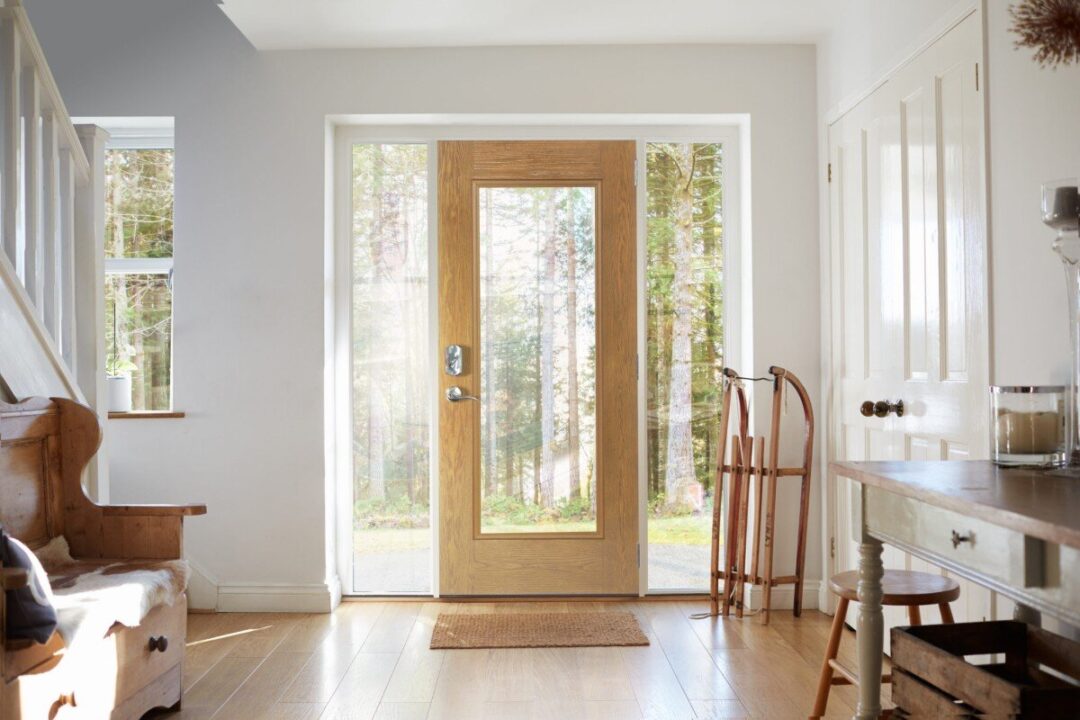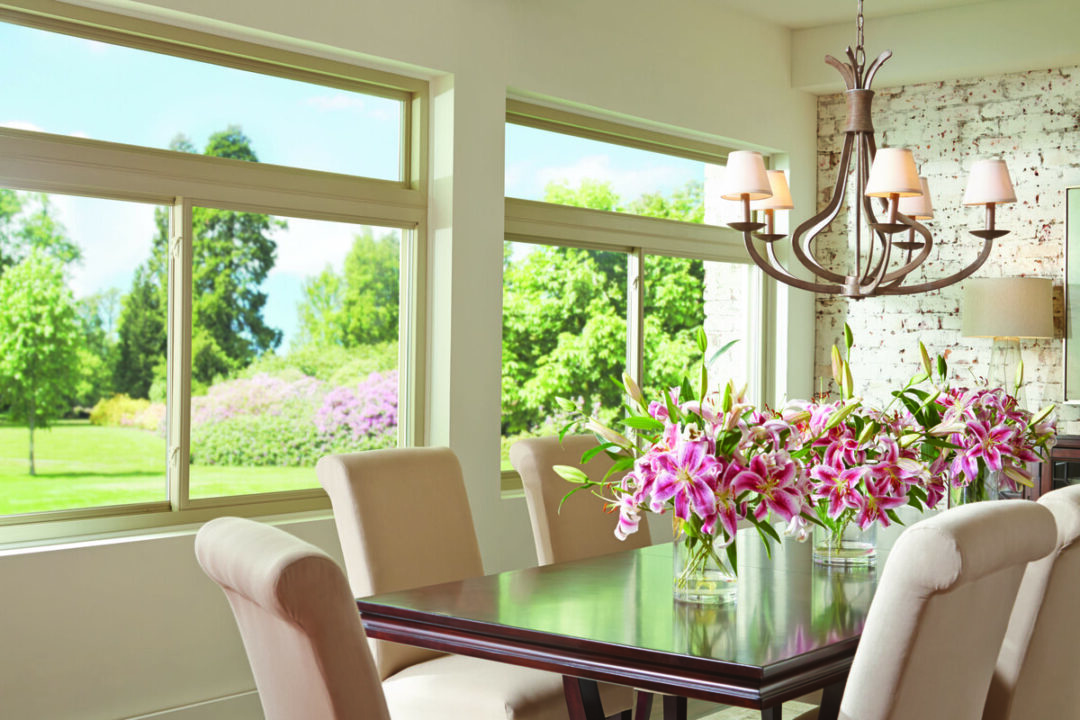A garden window is a small projecting window that extends outward from the exterior wall of a house, creating a mini-greenhouse-like ledge inside the home. Often installed above kitchen sinks or counters, garden windows are specifically designed to maximize natural light and provide a sheltered spot for plants, herbs, and decorative items. With glass on three sides and a sloped glass top in many designs, these windows bring sunlight deeper into living spaces and create a charming architectural accent that blends function with style.
Thermal King has helped Omaha homeowners just like you find the perfect windows for their home and budget! In this article, we will discuss garden windows and explore the many benefits they bring to a home.
How a Garden Window Differs from Other Window Types
Garden windows are sometimes confused with bay or bow windows, but they are distinct in size, purpose, and form. A garden window is typically smaller — more like a shallow box that projects only a foot or two from the wall — while bay and bow windows create larger alcoves and seating areas. Unlike typical picture windows that are fixed and flat, garden windows have multiple panes including side panes and a top light, increasing the amount of daylight entering from multiple angles. Operable vents are sometimes included to allow airflow, but many garden windows are primarily fixed to maintain a consistent microclimate for plants.
Where skylights and roof windows admit light from above, garden windows bring light horizontally and frontally into the room. This makes them especially useful in kitchens where counter space and sunlight are both at a premium. For homeowners looking to grow kitchen herbs year-round or to display succulents and orchids, garden windows create a protected niche that ordinary windows cannot replicate.
Benefits of a Garden Window
One of the most immediate benefits is sunlight. Garden windows typically have glass on three sides plus an angled top, which increases solar gain and spreads light into the room. This makes them ideal for growing plants that need steady, indirect light. For urban dwellers without access to outdoor garden plots, garden windows offer the chance to cultivate fresh herbs and small vegetables inside the home, improving both convenience and food freshness.
Beyond plant care, garden windows enhance interior aesthetics and perceived space. The projection creates a visual focal point and a sense of depth, often making a room feel larger and airier. They also provide an extra ledge for storage or display — a convenient spot for cookbooks, spices, small decorative objects, or personal mementos. In kitchens, this can free up counter space while keeping frequently used items within reach.
Energy considerations matter as well. When designed with energy-efficient glass and insulated frames, garden windows can contribute positively to a home’s thermal performance by admitting passive solar heat during colder months. Careful orientation and shading are necessary to avoid overheating in summer, but modern low-E coatings and double- or triple-pane glazing mitigate heat loss in winter and excessive heat gain in summer. According to industry data, properly specified windows can reduce overall heating and cooling costs compared with older single-pane installations.
Design and Components
A typical garden window consists of a framed box that projects from the home, with fixed panes on the front and sides and a slanted glazing panel on top. The frame may include a sill or shelf inside for planting, and some models have hinged vents on the sides to allow airflow. Structural supports, like brackets or a reinforced bottom frame, are required because the window projects outward and must carry the load of glass, frame, and any plants or decor placed on the interior shelf.
Important components to consider include the frame material, glazing type, weatherstripping, and flashing. Frames come in vinyl, wood, aluminum-clad wood, and fiberglass. Each choice balances cost, maintenance, and thermal performance. Glazing options range from single-pane to double- and triple-pane insulated glass units (IGUs) with low-emissivity (low-E) coatings and inert gas fills like argon or krypton for improved insulation. Flashing and proper sealing are crucial to prevent water intrusion where the projection meets the wall and the roofline above.
Materials and Finish Options
Vinyl frames are cost-effective and low maintenance, resisting rot and requiring minimal painting. Wood frames offer traditional warmth and are often chosen for historic or craftsman-style homes; they must be properly sealed and painted to resist moisture. Aluminum-clad wood combines a wood interior for aesthetics with a durable aluminum exterior for weather resistance. Fiberglass is durable, dimensionally stable, and energy efficient but tends to be more expensive. Exterior finish and trim choices can either accentuate the projection as an architectural feature or allow it to blend with existing siding.
Where to Install a Garden Window
Kitchen walls above sinks or counters are the most common location for garden windows because of the dual benefits of light for plants and convenience for cooking tasks. Laundry rooms, sunrooms, and small home offices can also benefit from the added light and shelf space. Placement should consider compass orientation: east- and south-facing windows deliver bright morning or full daylight, which is excellent for many herbs and vegetables, while north-facing garden windows provide gentler, diffused light suited to shade-tolerant plants and decorative foliage.
Practical installation considerations include the presence of cabinetry, plumbing, electrical, and the structural makeup of the wall. A garden window installation typically requires cutting a larger opening than a standard window and reinforcing the framing around it. Because the window projects outward, exterior trim and flashing must be carefully integrated with roofing or siding. Local building codes and, in some cases, homeowner association guidelines may dictate allowable exterior modifications, so it is important to confirm requirements before proceeding.
Cost and Installation Timeline
Costs vary widely depending on size, frame materials, glazing options, and labor. A basic vinyl garden window might start in the low hundreds of dollars for the unit alone, but full installation by a professional, including structural reinforcement and exterior finishing, commonly ranges from a few hundred to several thousand dollars. Upgrading to energy-efficient double- or triple-pane glass, wood or fiberglass frames, and custom trim can increase the total. A typical installation timeline from demolition to finishing often spans one to three days for a straightforward retrofit, but more complex jobs with structural modifications or exterior siding replacement can take longer.
Long-term value should be assessed beyond initial cost. Energy-efficient windows can improve comfort and reduce utility bills, while the enhanced aesthetic appeal may increase home resale value. Real estate listings frequently highlight well-lit kitchens and unique architectural features; a garden window can be a selling point when marketed appropriately. Homeowners considering a DIY installation should have carpentry skills and knowledge of flashing and waterproofing; otherwise, hiring a licensed contractor is recommended to ensure durability and code compliance.
Maintenance and Care
Maintaining a garden window is relatively straightforward but important for longevity. Regular cleaning of glass panes keeps light transmission high and prevents buildup of dust or pollen that could affect plants. Inspection of seals, caulking, and flashing should be done at least annually to catch any gaps or deterioration that could allow moisture infiltration. For wood frames, periodic painting or staining protects against rot and weather damage; vinyl and fiberglass frames typically require only a wipe-down with mild detergent.
Plant care in a garden window has its own routine: rotating pots to avoid uneven growth, monitoring for pests, and using saucers or trays to catch excess water to protect the sill and frame. Lightweight pots and trays are preferable to avoid overloading the interior shelf. If the window includes operable vents, these should be checked to ensure smooth operation and effective screening to keep insects out while allowing airflow.
Seasonal Considerations
During summer months, direct sun through a garden window can create a greenhouse effect that stresses some plants and overheats the kitchen. Removable shades, UV-filtering films, or operable vents help moderate temperature and light. In winter, sealed insulated glazing reduces heat loss, but adding insulating window film or interior storm panels can further improve comfort in colder climates. Plants that are not cold-hardy should be monitored for drafts near the frame or for radiators that might rapidly change temperature near the planting shelf.
Best Plants for Garden Windows
Herbs such as basil, parsley, chives, and thyme thrive in bright, sunny window ledges and are practical for culinary use. Succulents and cacti are excellent choices for south- or west-facing garden windows because they tolerate intense light and dry conditions. Shade-tolerant houseplants like pothos, spider plants, and certain ferns do well in north-facing garden windows that receive gentler light. Orchids, African violets, and small citrus trees can also be successful with attentive watering and humidity considerations.
When selecting plants, size and weight constraints are important. Compact varieties, dwarf cultivars, and container-friendly herbs are preferable. Grouping plants with similar light and water needs makes care simpler and reduces the risk of over- or under-watering. Adding a moisture-resistant tray or removable liner simplifies cleaning and prevents water from contacting the sill or frame.
Comparison: Garden Window vs. Bay/Bow Window
Garden windows and bay/bow windows both project outward, but the purpose and scale differ. A bay or bow window creates a larger seating or storage alcove and typically consists of multiple operable windows configured to form an arc or angle. These are often used in living rooms and dining rooms to create window seats and dramatic architectural statements. Garden windows are more compact, focused on plant display and light for specific tasks like cooking, and generally easier to install as a retrofit into an existing wall opening.
From a cost perspective, bay and bow windows are usually more expensive due to larger size, more complex structural requirements, and the need for additional framing or roofing integration. Garden windows can deliver some of the same light and projection benefits at a lower cost and with less structural upheaval, making them a practical choice for kitchens and smaller rooms.
Expert Window Replacement in Omaha
Garden windows offer a unique combination of form and function: they extend living space outward by creating a bright, sheltered niche ideal for growing plants, showcasing décor, and enhancing kitchen usability.
We hope this article has helped you refine your choices for window replacement materials and will help you budget for your window replacement project. Thermal King offers premium windows from leading manufacturers like ProVia and Marvin.We have completed over 10,000 window replacement projects in the Kansas City area. We’d love to see if we would be a good fit for your project. Contact us today to get started!




